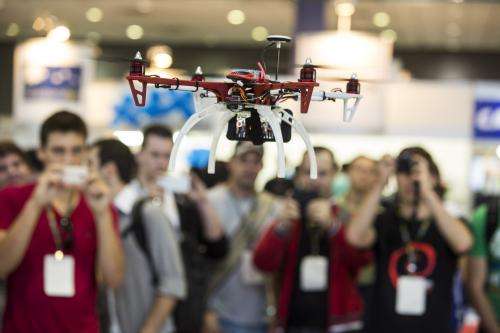Drones finally get MPs talking tougher on privacy laws

The increasing use of drone aircraft in Australia may finally lead to a long overdue change in privacy laws to protect against the use of remote eyes and ears in invasive technologies.
The call for tougher legislation comes in the report Eyes in the Sky: Inquiry into drones and the regulation of air safety and privacy, released this week from the House of Representatives Standing Committee on Social Policy and Legal Affairs.
A drone by any other name
Drones are miniature helicopters (with very sophisticated cameras mounted on them) that go by a number of other names: "unmanned aerial vehicles" (UAVs), "unmanned aircraft systems" (UASs), and "remotely piloted aircraft" (RPAs) which is my preference.
I have written before on my thoughts and concerns over this new surveillance tool that is taking to Australian skies on a daily basis.
So it is very pleasing to see that the Federal Parliament has recently applied its mind to the phenomenon.
Interesting to note that the Committee, chaired by Nationals backbencher George Christensen, comments upon the unfortunate nature of the term "drone".
Industry groups expressed a desire to avoid the term 'drone', as a result of perceived negative connotations arising from an association with the United States military's program of 'targeted assassinations'.
Despite sharing my preference to use "remotely piloted aircraft", the report continues to use "drones" liberally (even in the title of the report!).
The use of drones
The Committee provides an excellent snapshot of the current and potential uses and abuses of these clever little inventions, and makes a series of well-considered recommendations regarding the policy imperatives arising from them.
It highlights the benefits of using RPAs for agricultural and mining surveying, aerial photography, bushfire spotting, beach patrolling, sports webcam deployment, and search and rescue assistance, to name a few.
But RPAs give rise to some concern for public safety, especially given the possibility of one of them straying into airspace and colliding with other aircraft, or crashing to earth.
Back to privacy
Moreover there are privacy concerns. How many of us would want our neighbours deploying an RPA over our backyard while we are sunbaking or even just attending to the family barbecue?
How many would like to see the team from our local newspaper or television station trying to get closer to a family during a moment of private grieving?
In my earlier discussion of RPAs, I isolated a number of key areas that needed policy attention:
- how collected images and other data would be stored and whether RPA targets would have access to these images
- how to hold RPA operators to account for any excesses in the manner in which images are gathered
- how to provide a remedy should people wish to pursue legal action in the event of an RPA practice that has offended their sensibilities
- how to define the role of the Civil Aviation Safety Authority (CASA) as a preferred regulatory authority.
The Committee has addressed all of these concerns, although it did this primarily by referring specific questions and issues to other bodies (such as CASA and the Australian Privacy Commissioner) best equipped to deal with them.
But I've said before that parliaments are the most appropriate bodies to legislate the extent to which individuals can be subjected to (or protected from) surveillance from a camera mounted on a miniature helicopter.
Tougher privacy laws needed
The Committee also recommends that the Australian Government consider, by July 2015, introducing legislation which provides protections against any privacy invasive technologies.
This would include consideration of a new tort of "serious invasion of privacy", a remedy that is well established in New Zealand and the United Kingdom and in a number of US states.
Australian governments, in contrast, and under pressure from our media moguls, have been pussy-footing around this area for many years, notwithstanding repeated calls from law reform bodies to enact such a tort.
Some High Court judges have previously given strong indication that they do not see it as their role to be the harbingers of any such change. It must come from parliament, they said in the ABC v Lenah Game Meats case more than a decade ago.
The Christensen Committee has taken up the cudgel in pursuit of this specific challenge in Recommendation 3 when it asks the Federal Government to consider:
[…] the creation of a tort of serious invasion of privacy, or include alternate measures to achieve similar outcomes, with respect to invasive technologies including remotely piloted aircraft.
Further limits on eyes (and ears) in the sky
Another strong and timely recommendation concerns the harmonisation of the current dog's breakfast of surveillance and listening devices legislation found at the Commonwealth level and in our various states and territories.
The antiquated legislation in Queensland, Tasmania and the ACT, for example, makes no reference to cameras at all, let alone cameras buzzing above our heads.
The Committee asks the Council of Australian Governments (COAG) to put in some hard yards here, especially around harmonisation of the rules relating to the use of RPAs by law enforcement officials in the tracking and pursuit of those suspected of having committed criminal offences.
The Committee has done us a great service by setting out the parameters that we need to consider in order to balance the advantages and disadvantages of this amazing new apparatus. We now await the fate of their timely recommendations.
Source: The Conversation
This story is published courtesy of The Conversation (under Creative Commons-Attribution/No derivatives).
![]()

















